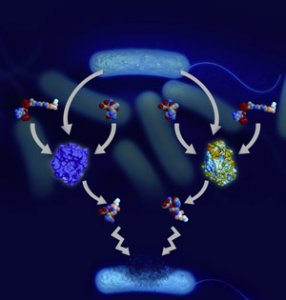
Outsmarting Bacteria: Researchers develop faster method to generate new antibiotics
Researchers at the University of Michigan’s Life Sciences Institute have developed a new method to rapidly generate and test novel antibiotic-drug candidates. The technique could provide scientists with a new tool in the fight against antibiotic-resistant bacteria.
LSI research assistant professor Sylvie Garneau-Tsodikova and her colleagues essentially outsmarted bacteria by using the microbes’ own defenses against them. The research team reports its findings in the January edition of the journal ChemBioChem.
“We’ve taken what the bacteria used to kill the antibiotic as a tool to make new antibiotics,” said Garneau-Tsodikova, who is also the John G. Searle assistant professor of medicinal chemistry.

From the Cover Picture : Exploring the Substrate Promiscuity of Drug‐Modifying Enzymes for the Chemoenzymatic Generation of N‐Acylated Aminoglycosides (ChemBioChem 1/2010)
Decades of clinical use – and overuse – have made bacteria smarter and trickier to subvert. As a result, many antibiotics are losing their efficacy against bacteria that have built up resistance to them.
“There’s currently a huge problem associated with bacterial resistance to antibiotics as bacteria come up with tricks to become resistant to all the drugs that scientists discover,” said Garneau-Tsodikova.
Resistance is a problem in the aminoglycoside family of antibiotics, which are commonly used to fight serious bacterial infections and genetic diseases, and as anti-HIV drugs.
Because they have complex structures containing numerous chemically identical amine and hydroxyl functionalities, attempts to create new aminoglycoside antibiotics have been limited. They are hard to synthesize, and one compound takes multiple chemical steps to build, which can translate into years of work. And results are not guaranteed: The compound could turn out to be inactive, and the search would start all over again.
Bacterial resistance to this type of antibiotic happens because the substrate promiscuity is strong, which means the bacteria are able to take a lot of aminoglycosides, modify them, and kill them by using, among others, enzymes called aminoglycoside acetyltransferases. The enzymes modify and eventually kill the drug by adding a small part of the co-substrate, co-enzyme A, to the drug. “If the enzyme acetylates the drugs, the drugs become inactive,” said Garneau-Tsodikova.
While much is known about the substrate promiscuity of these enzymes, little was known about the co-substrate promiscuity itself?the enzyme created by the bacteria to kill the antibiotics and render them ineffective.
Garneau-Tsodikova’s lab, along with collaborator Micha Fridman at the University of Tel Aviv, sought to determine whether these enzymes would be co-substrate promiscuous and found that they are. Because they are now using an enzyme, which is easier to target and control, they are able to make new compounds and test them in one step, taking a day or two at the most.
“We’ve taken what the bacteria used to kill the antibiotic as a tool to make new antibiotics by using the co-substrate promiscuity to generate novel drug candidates. The method rapidly tells us which drugs are worth further pursuing,” said Garneau-Tsodikova.
Their method also requires a much smaller amount of the drugs generated for testing, as little as a couple of micrograms. Garneau-Tsodikova has also used this method on other acetyltransferase systems with success. Her lab continues to build on this concept.
The work was supported by the Life Sciences Institute and the U-M College of Pharmacy and by the Department of Chemistry at the University of Tel Aviv. A United States-Israel Binational Science Foundation grant also supported part of this work.
###
Contact: umichnews@umich.edu
View original article
